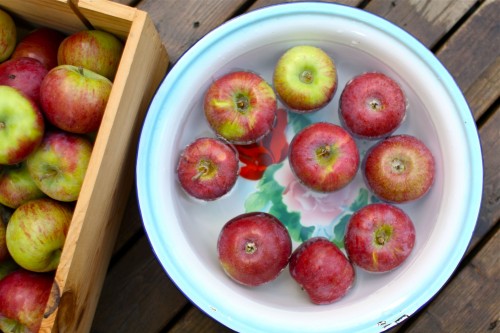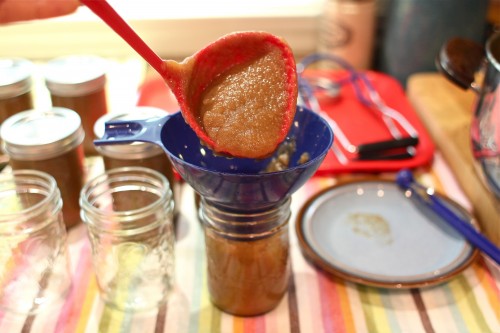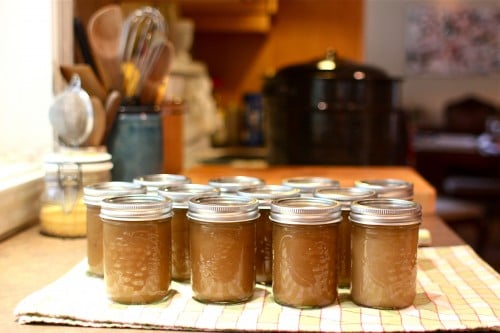
What is there really to say about applesauce, except that it is essential? It’s one of the first solid foods most ever eat and remains high on the comfort food scale as you grow older. Making applesauce every autumn is obligatory around here and an obvious addition to our Canning 101 series.
Right now families are flocking to the orchards on the weekends for a favorite Québec fall pastime: apple picking. The apples that are gathered can keep for a few weeks or even months if stored properly, but the best way to extend their enjoyment is to preserve the harvest through canned homemade applesauce.
Stirred into yogurt, baked into cookies, or layered between crêpes are just a few of the ways we enjoy our applesauce. Then there’s always straight from the jar, with a spoon, just like when we were teething tots.
Here is a basic step-by-step tutorial on how I make and can my applesauce. It’s straightforward, easy to make in large batches and just delicious!
WASH FRUIT
Begin by washing your apples thoroughly. This is a great job for little helpers, who can also help twist off stems. Apple skins add flavor and color to applesauce, so we don’t remove them. As a bonus, leaving the skins on makes our job that much easier!
Here I’ve used Cortland apples, which are quite sweet and one of my favorite local varieties. McIntosh are excellent for sauce as well, but really, almost any variety of apples can be used for applesauce.
This tutorial would also be lovely with pears.
CHOP, CORE & COOK
Using a sharp chef’s knife, quarter all the apples. With a paring knife, remove the core and toss quarters into a large, heavy bottomed pot. Add about 1 cup of liquid per 5 lbs of apples. I use apple cider, but water or even apple juice works fine, too.
Add any flavorings you would like now such as lemon peel (if the apples are particularly bland) or a cinnamon stick. If you are going to be baking with your applesauce, you may want to leave it neutral.
I’ve added a few vanilla beans, split and seeded, and a cinnamon stick. I know my sauce will mostly be enjoyed stirred into yogurt or on its own, so I’m adding flavorings to make it a little more dessert-like.
Turn the burner to medium, partially cover the pot with a lid, and bring to a simmer. Reduce heat to medium low and allow to cook down slowly. Be sure to stir occasionally and keep an eye out for signs of scorching.
CHOOSE TEXTURE AND PURÉE
Once the apples have cooked down and softened considerably, they are ready to be ‘sauced’.
If you want chunky applesauce, fetch the skins out with tongs, and use a potato masher to mash the cooked apples. If you prefer smooth apple sauce, run the cooked apples through a food mill; this will both weed out the skins as well as give you a lovely smooth texture.
Not yet the owner of a food mill, I removed my cinnamon and vanilla bean from the pot and passed my cooked-down apples through a wire sieve. By using the back of a ladle to push the soft apples through the sieve, the task goes quickly. A flexible bench scraper also works well.
Return the purée to the pot and reheat. At this point you may can the sauce as it is or cook it down slowly some more for a thicker consistency.
Meanwhile, prepare the hot water bath, the utensils and equipment and everything needed to can as instructed in our post on Canning Basics.
HOT-PACK PROCESSING IN BOILING-WATER BATH
Ladle hot applesauce into hot, sterilized jars, filling them to within 1/2 inch of the tops. Wipe rims with a clean cloth, top with lid and screw ring. Once all jars are filled, lower each one carefully into the hot water bath until the pot is full. Do not overcrowd!
Bring water to a boil and then process for twenty minutes.
Once processing time is finished, turn off heat and carefully remove jars with a canning jar lifter. Place on a clean tea towel on the counter to cool.
Allow to sit undisturbed for 24 hours. Tighten rings, label and store in a cool, dark place.






0 comments:
Post a Comment